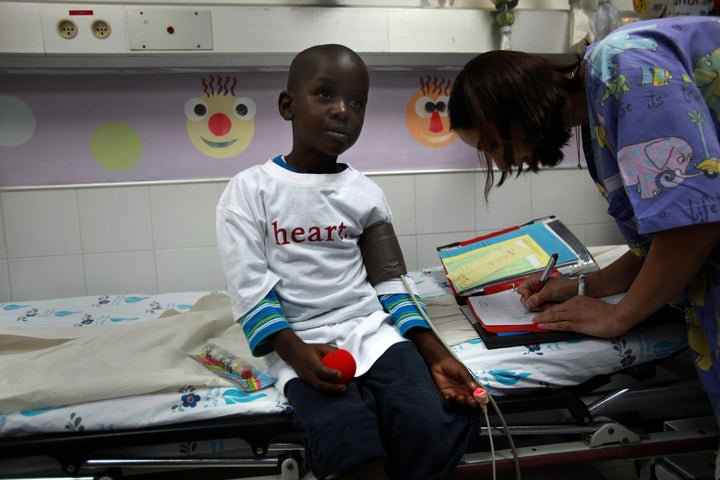
The American Stroke Association's International Stroke Conference 2011 was held last week in Los Angeles. Among the many important research findings reported was this bit of profoundly disquieting news: strokes are occurring with increasing frequency in people under age 35. Worse still, a marked increase in the rate of stroke was noted in children ages five to 14.
As a physician who has seen far too much bad stuff happen to far too many good people over the years, I truly can't imagine much worse than a stroke in a child. Formally a "cerebrovascular accident," induced more often by ischemia and less often by intracranial bleeding, a stroke is to the brain what a myocardial infarction (heart attack) is to the heart: part of the organ dies. A child has a stroke and part of a brain that should be thriving, burgeoning with newly acquired experience and knowledge dies. And with it dies some function, perhaps the ability to speak, or the ability to move one side of the body. With it dies childhood.
That this is a trend in modern epidemiology is both tragedy and travesty. The researchers readily acknowledge they don't know for sure why stroke rates, declining in adults over age 50, are rising in children and young adults. The study in question, by investigators at the CDC, was simply a review of hospitalization records between 1994 and 2007. The analysis was designed to show what, but not why.
But that does not preclude some educated guesses, by the researchers themselves and the rest of us. The decline in strokes in older adults is almost certainly due to better treatment of hypertension, the leading cause of stroke, and to a lesser extent the modification of other risk factors for cardiovascular disease, such as lipid-lowering with statin drugs. Such vulnerabilities are routinely being sought, found and modified in adults known to be in the at-risk group.
But of course, stroke and ischemic heart disease are not expected in the pediatric age group. Historically, there has been no cause to look systematically for risk factors of vascular disease in this population, let alone apply the use of antihypertensives and statin drugs to avert calamity.
It is nothing short of calamity that it has come to this. The researchers's best guess, and mine, is that the migration of stroke down the age curve is being propelled by epidemic obesity, diabetes and rising rates of hypertension in our children. We can choose to be shocked by the advent of stroke in children, but it was, in fact, predictable.
Predictions need not be about what comes true. Grim predictions can motivate preventive responses so the adversities they foretell never materialize. Forewarned can be forearmed.
I have, for years, been predicting heart disease as a routine, pediatric condition -- in the hopes it would never come true.
The logic behind my rather lonely rants on this topic has been quite straightforward. A group of experts in cardiovascular medicine called the Adult Treatment Panel of The National Cholesterol Education Program issues guidelines for health care providers in the identification and management of cardiac risk factors in our patients. Those guidelines tell us that we should treat our patients with diabetes as if they already were known to have coronary heart disease, because the link between the two is so strong.
When I went to medical school, I learned about two kinds of diabetes mellitus: juvenile onset and adult onset. What we now call type 2 diabetes is diagnosed more and more commonly in children under the age of 10. But less than a generation ago, this very condition was appropriately called "adult onset," because it occurred almost exclusively in overweight, middle-age adults.
If one chronic disease of midlife can migrate down the age curve to become a condition of childhood, what basis did we have to think that others wouldn't follow? What the Adult Treatment Panel says about diabetes in adults -- that it can be assumed to signal the presence of heart disease -- is true in children, too, until proved otherwise. We have little cause to think diabetes does different damage to small bodies than to larger ones.
So, when 16, 17 and 18 year-olds have had adult onset diabetes already for a decade or more, shouldn't we expect to start seeing them in emergency rooms with angina pectoris and myocardial infarction? I have long thought we should.
And regrettably, I have had incremental indications over time that my predictions were coming true.
Several years ago, I made my usual grave prediction about the advent of coronary disease in teenagers in Atlanta, Georgia, at an American College of Cardiology meeting there. One of the physicians in my audience told me she had heard that some 7,000 teenagers had heart attacks in the U.S. the year prior. I could not confirm that statistic, but there is more and more medical literature referring to this trend.
I gave a talk in Missouri a few years back, after which a dietitian in the audience told me about a 17-year-old boy whose care she was involved in, who had undergone a triple coronary bypass. To the best of her knowledge, this boy had no unusual genetic predisposition to heart disease. Just obesity, type 2 diabetes at an early age, and the obvious, predictable consequences.
When I first started making a fuss about this 10 years back or more, my audiences were dubious and uncertain of my reasoning. More recently, they have seemed less stunned, more convinced and deeply concerned. Now they are starting to provide evidence to prove me right. This is a very unhappy trend. And frankly, while I was warning against the advent of angina as an adolescent rite of passage alongside acne, even I didn't envision strokes in children under the age of 10.
Which brings us back to the new research findings. We don't know with certainty the causes of a rising rate of stroke in our children. But with the stakes this high, do we really want to wait for more data? The best way to predict the future is to create it, and I would very much like to predict a future in which the only stroke my children and grandchildren need worry about is the stroke of a dissatisfied teacher's red pen.
Modern trends in chronic disease constitute a crisis. A crisis is a dangerous opportunity, because recognition of danger inspires will for change.
We can change our ways, and protect our children and grandchildren from the heart attacks and strokes of unkind fate -- by becoming a society that honors feet and forks as master levers of medical destiny, rather than relying so heavily on stethoscopes, scalpels and statins in the aftermath of disaster. By doing all that is required to make eating well and being active lie along the path of least resistance.
The list of interventions to get us there is long, but not complicated. Every policy or practice that isn't a part of the solution is a part of the problem -- and a potential threat to a child. Vote accordingly.
In defense of our children, we should act -- even as we await data to verify likely causes. We should not attribute lamentable trends in epidemiology to unkind strokes of fate. The fate in question is almost certainly in our own hands. The bell curve of chronic disease is tolling ever more loudly for us all.
It is past time to answer the alarm with the urgency it warrants.
